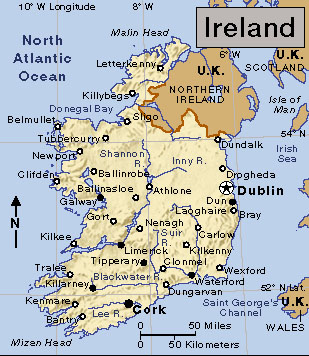INTRODUCTION TO IRELAND
Ireland is a small, independent country located in northwestern Europe. The country's official name is the Republic of Ireland. Dublin is the capital and largest city. The country occupies about five-sixths of the island of Ireland. The remaining one-sixth of the island is occupied by Northern Ireland, which is part of the United Kingdom of Great Britain and Northern Ireland.
In Gaelic, the ancient language of Ireland, the country is called Eire (pronounced AIR uh). Gaelic and English are the country's two official languages. Ireland also has long been known by the poetic name Erin. Ireland is also known as the Emerald Isle. It is called this because of its beautiful green countryside. Rolling farmlands, which are mainly pasture, cover much of the central part of the country, and mountains rise near the coasts.
Ireland is divided into 26 counties, and some of the counties are known for special features. For example, County Kerry is famous for its mountains and the scenic Lakes of Killarney. County Waterford is known for its delicate cut glass, and County Donegal is famous for its tweed cloth.
Many people consider the Irish to be exceptionally warm-hearted and friendly. The Irish also have a reputation for hospitality, close family ties, and skill as writers and storytellers.
The Irish have a long history that includes many hardships and struggles. In the 1840's, a potato blight and the starvation and disease that followed caused the deaths of about a million people and at least as many people left their homeland. After this famine, a shortage of jobs and other problems caused emigration to continue. As a result, little more than half as many people live in Ireland today as lived there in 1845.
Ireland was under British rule for hundreds of years. Ireland gained its independence from Britain in 1921.
Geography
The lowlands cover most of central Ireland. They include some wooded areas but consist principally of gently rolling farmlands, which are mainly pasture. They also include peat bogs (former swamps composed of partly decayed plants). Peat bogs cover about a tenth of Ireland. Most of them are located in the central and western parts of the country.
Most of Ireland's mountains rise near the coasts and border the lowlands. The chief mountain ranges are the Donegal Mountains in the northwest, the Mountains of Mayo and the Mountains of Connemara in the west, the Mountains of Kerry in the southwest, and the Wicklow Mountains in the east. Ireland's highest peak, 1,041-meter Carrauntoohill, rises in the Mountains of Kerry.
Many inlets and bays cut deeply into the west coast of Ireland. Because of them, no point in the country is more than 110 kilometers from the sea. Parts of the coast are lined with high cliffs of solid rock. Two large bays on the west coast, Galway Bay and the mouth of the River Shannon, provide harbors for the ports of Galway and Limerick. Other important bays on the country's west coast include Bantry, Clew, Dingle, Donegal, and Sligo bays. Hundreds of small islands lie off the west coast of Ireland. The largest of these islands include Achill Island, the Aran Islands, and Valentia Island.
The south and east coasts are straighter and less rugged than the west coast. On the south coast, the ports of Cork and Waterford lie on excellent natural harbors. Dublin Bay, on the east coast, provides a harbor for Dublin, the chief Irish port.
Ireland's River Shannon is the longest river in the British Isles. The Shannon begins in northwestern Ireland and flows southwest 370 kilometers into the Atlantic Ocean. The River Liffey begins in the Wicklow Mountains, winds northeast 121 kilometers, and flows into the Irish Sea at Dublin. Its mouth forms Dublin Bay. Other Irish rivers include the Barrow, Nore, and Suir in the southeast; the Boyne in the northeast; and the Moy in the northwest.
Most of Ireland's lakes lie in the west. The lakes are called loughs (pronounced lahks). Three major lakes--Lough Allen, Lough Ree, and Lough Derg--lie along the course of the River Shannon. The scenic Lakes of Killarney in the southwest consist of Lower Lake, Muckross Lake, and Upper Lake.
Ireland has a mild, wet climate. Temperatures average about 5 °C in winter and about 15 °C in summer. Ireland's climate is influenced by the North Atlantic Current, a warm ocean current that flows north past the British Isles. In winter, westerly winds blow across the current and bring warmth to the country. In summer, ocean waters are cooler than the land, and westerly winds blowing across the waters help keep temperatures mild. The ocean winds also bring much rain to Ireland. The heaviest rains fall in the mountainous regions along the west coast. The rainfall there averages about 150 centimeters a year, with some areas having as much as 250 centimeters a year. The lowlands have about 90 centimeters of rain a year.
The southern and western parts of Ireland have the longest growing season in the British Isles because of their mild climate and plentiful rainfall. In many areas, pasturelands can be used the year around.
Capital: Dublin.
Official Languages: English and Gaelic.
Area: 70,284 sq. km.
Greatest distances--north-south, 465 km; east-west, 285 km. Coastline--2,797 km.
Elevation: Highest--Carrauntoohill, 1,041 m above sea level. Lowest--sea level along the coast.
Population: Estimated 1996 population--3,462,000; density, 128 persons 49 per sq. km; distribution, 58 percent urban, 42 percent rural.
Chief Products: Agriculture--barley, beef and dairy cattle, hogs, horses, potatoes, poultry, sheep, sugar beets, wheat. Manufacturing--alcoholic beverages, chemicals, clothing, computers, machinery, medicines, metal products, paper, printed materials, processed foods, textiles.
National Anthem: "The Soldier's Song."
Money:
Basic unit--Irish pound (punt) / Euro.
